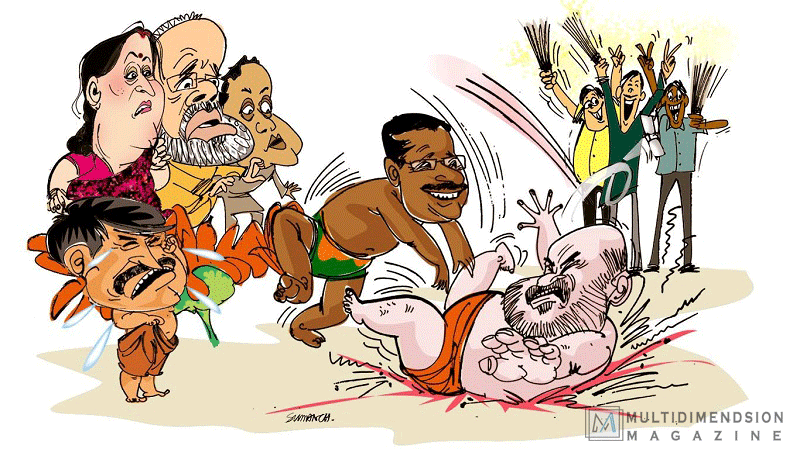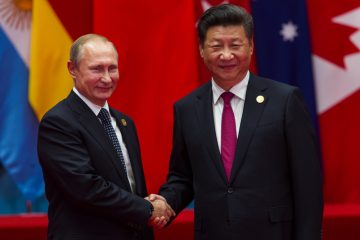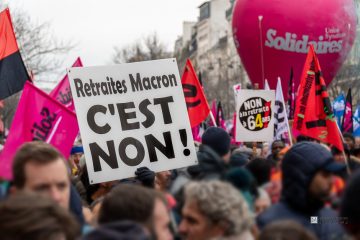From director’s desk
Written by : Jayanta Chakrabarty
Illustration by : Suman Choudhury
In the beginning of January 2014, I was in Delhi. Dhoom 3 was released in theatres a few days back and the Aam Aadmi Party (AAP) had formed a minority government in a hung assembly with outside support of 8 legislative members of Indian National Congress, with Arvind Kejriwal as the Chief Minister. The Bhartiya Janata Party (BJP) was biting the dust instead of being the signal largest party with 31 elected members in an Assembly of 70 seats. It was a tumultuous political situation; it was the time of realignment of political forces. The National election was approaching and Narendra Modi had started making waves all over India, becoming a personage of larger than life, Arvind Kejriwal with no prior political experience made the BJP fail to impose its hold on the National capital. The uncomfortable alliance between the AAP and the Congress Party lasted only 49 days. In fact, the AAP came into existence on the wave of India Against Corruption movement demanding a Jan Lokpal Bill since 2011, drawn up by Anna Hazare and a number of other civil society activists including Arivind Kejrwal, seeking the appointment of an independent body to investigate corruption cases.
The end of contrived bonhomie with the Congress to attain political power left a bitter and disappointing feeling among the ranks of the AAP as Arvind Kejriwal founded the party following his differences with his guru Anna Hazare where the later desired that the anti-corruption movement should remain politically unaligned.
But the support of a large section of Delhiites had boosted the moral of Arvind Kejriwal and he fell into the dream of being part of resistance against the tsunami wave of Modi. AAP fielded 434 candidates in the 2014 general election and Kejriwal himself declared candidate against Modi in the constituency of Varanasi. His dream was shattered, the party got only 2% of all the votes cast nationwide, 414 of its candidates forfeited their deposit, and he himself trailed far behind Modi with a difference of 370000 votes. On the other hand, the party won 4 seats in Punjab, and 32.9 per cent of votes in Delhi without winning a seat.
The failure didn’t demoralize Kejriwal. He rather took notice of his own lightweight stature in front of a matured political figure like Narendra Modi who has experience of being the chief minister of Gujarat for three successive terms and has gained the reputation being the vanguard of economic miracle came in that state overriding the stigma of anti-Muslim riot sticking to his persona since 2002.
The BJP won 2014 general election on Modi wave presenting a mixed package of Hindu nationalism and economic prosperity for all with corruption-free administration.
But Kejriwal led AAP to win 67 of 70 constituencies in the 2015 Delhi Assembly elections with 54.3 per cent of votes and the BJP got only 3 seats just a few months after its imposing victory in National election and the Modi-Magic was still overpowering.
It was interesting to find out a new trend that the Delhiites set in Indian politics, giving chance to a novice politician who actually served an anti-establishment role while being at the top of the administration during his 49 days tenure, but he could make his point on proper functioning of the Delhi administration by the elected legislative body as the central government is in charge of maintaining law and order and the Lieutenant Governor appointed by the above said, although having no legislative powers, only an advisory role in the governance of Delhi. The arrival of an outsider like Kejriwal did upset the political status quo in Indian Capital.
The AAP won the election on its promises to improve the quality of day-to-day life of the denizens, increasing spending on public education et health systems which were in a miserable state and putting the end of corruption in the administration. But the first three years, he had to face constant hindrance to put his plans in action due to adverse role of the Lieutenant Governor who took order of the Central government run by the BJP whose sole intention was to discredit Kejriwal in front of the Delhiites not for delivering on his promises. On the other hand, the country went through an unrelenting wave of nationalism mixed with Hindu religious fanaticism with actions like banning on killing cows and demonetization, which put blow to the growth of the economy.
The AAP lost the Delhi Municipal election in April 2017, which complicated further the political life of Kejriwal. But as time passed, Kejriwal grew up politically, mastering the art of dealing his adversaries with patience. Finally he got the result of his endeavour when the Supreme Court of India pronounced its judgment in July 2018 declaring that the lieutenant governor of Delhi had no independent decision-making powers and was bound to follow the “aid and advice” of the Delhi chief-minister-headed council of ministers of the Government of Delhi on all matters except those pertaining to police, public order and land.
This historical decision has paved the way of Kejriwal Era in Indian politics, which is about facilitating a social welfare system to alleviate the vulnerable citizens out of poverty. The gimmick of Demonetization has created a huge unemployment among the poorer section of Indian society, even a part of middle class, destroyed small business and unplanned GST application has multiplied the disparity.
Arvind Kejriwal has well understood the problem of common people and that a surplus income can push consumer capacity and pull the economy out of stagnancy. Free electricity and water supplies, infrastructural development brought into public schools and hospitals have provided the vulnerable section of the population the time and space to think of their future.
The national election in 2019 was hold on high-pitched Nationalist sentiment on Pulwama and Surgical Strike (not questioning neither the time or exactitude) and people voted for a strong central government which can assure the security of the country, even if the electors were going to sleep in nights without food in stomach. The BJP has secured a resounding victory with its partners from National Democratic Alliance (NDA), and AAP got no seats and only 18.1 per cent of the votes.
As the NDA government has no clear plan to revive the ailing economy, it has opted for implementing all of its political promises like abolition de triple talaq, revoking the article 370 which gave special status to the State of Jammu and Kashmir and declaration of temple of Ram on the disputed land of Ajodhya.
All three actions seemed have popular support which even fractured the ranks in the opposition, and even the Muslim society didn’t react much against those actions.
But on the east side of the country, in Assam, the situation became complicated for the BJP where it in power with a variety of alliance. With the application of National Register of Citizens (NRC), 1.9 million people were declared non-Indians among those 1.4 Hindus, which gave a big blow to the mass support of the party. This forced BJP to push hurriedly the Citizenship Amendment Bill (CAB) into the Citizenship Amendment Act (CAA) providing a path to Indian citizenship for illegal migrants of Hindu, Sikh, Buddhist, Jain, Parsi, and Christian religious minorities, who had fled persecution from Pakistan, Bangladesh and Afghanistan before December 2014 and and will be in India till 31st Dec 2019 will be given the citizenship. Their citizenship procedure, which previously used to take 11 to 12years, will now take only 5-6 years to get the citizenship of India. Muslims from those countries were not given such eligibility. As the Home Minister Amit Shah made strong comments indicating the relation between CAA and NRC and vowed to throw the non-Indians out of the country, it created fear among the Muslim population of the entire country and provoked the anger liberal opposition parties.
Indian economy is still in its early development stage, poverty and illiteracy rate is high with a stupendous population of 130 crores. We are not China. The sociocultural and economic structure of our country is too diverse from North to South and West to East. The process of CAA and NRC will make people queue for an unlimited period, engaging their time and mind in finding papers to prove their origin (in a country where even cabinet ministers can’t produce their academic certificates of the degree they claim to have). Then what about 30 to 40 per cent of the population who live in remote villages, temporary slums and on the pavements under utter poverty who have hardly any papers to prove who they are. These people are an integral part in the current development process of our economy. Of course there are quite a number of immigrants from Bangladesh and Nepal and this a common scenario of all around the world. As Indian economy is stronger than those countries, they come here to earn living. Of course, a great number of Hindus (and Sikhs) are forced to take refuge in India fleeing Pakistan and Bangladesh due to religious persecution. So this is true for Hindus from Sri Lanka and Rohingyas from Bangladesh. Then what should be the parameter of CAA?
Who really think that those Hindus came to India from Pakistan and Bangladesh before 2014 don’t possess Indian resident documents already like Ration Cards, Aadhaar Card, Voter ID or Passport? Taking advantage of the loose administrative system and corruption, they have procured one of these documents, and so are the Muslim migrants. Now how will government find out who is real and who is false? And making people stand in queue for ages to prove it ?Do anyone has idea that how many years it might take? And how much money will it cost? Only in Assam, it took 10 years and 1600 crores. Finally on National level, in this process, the country might end up with at least 10 to 15crores people without proper documents and then reverification process will start. How much it might cost and the time? Does the government think that Indian Economy can sustain the shock which has not yet come out from the recession provoked by Demonetization.
Therefore, the strategy of demonizing the Shaheen Bagh protest movement and the opposition as Enemy Inside (anti-national or agent of Pakistan) didn’t work in the Delhi Legislative Election 2020. Kejriwal has attained enough political maturity not to put himself in trap set by the so-called Chanakya of current Indian politics. In fact, it is him who opted better strategy in the fight pointing on socio-development programmes, and knocked out Chanakya with his entire group.
In 2014, Kejriwal hurried to fight the aura of Narendra Modi, unprepared and inexperienced. In 2020, he has attained the good result of this effort, and he will definitely put a matching fight in 2024 General Election.
Perhaps a Real Dhoom 4.




